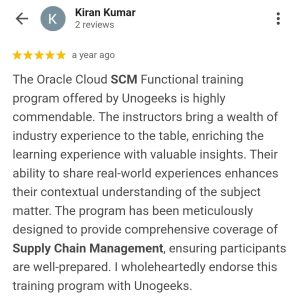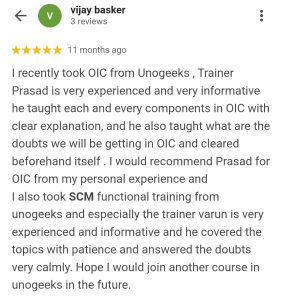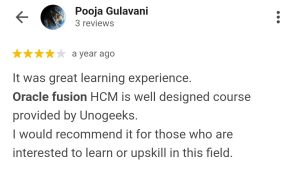
Oracle Fusion Financials Certification Training Course
Have Queries? Call Us
+91 73960 33555
1100+
Students Trained
5 ***** (701)
Ratings
50 Days
Duration
Course Demo Video

Our Students Work At
Oracle Fusion Financials Online Training Course Details
Introduction To Oracle Fusion Financials Online Training
What you’ll learn
- Understand Fusion Cloud Application, Navigation, Functional Setup Manager and Security
- Master and implement Oracle Fusion General Ledger
- Master and implement Oracle Fusion Accounts Payables
- Master and implement Oracle Fusion Cash Management & Tax
- Master and implement Oracle Fusion Accounting Hub
- Master and implement Oracle Fusion Accounts Receivables
- Master and implement Oracle Fusion Fixed Assets
- Implement Fusion FIN Modules Hands on for a Live Project
- Master All FIN Technical Skills – BIP, OTBI, FBDI, SDL, Sandbox, FRS & Smart View Reports
- We will provide most comprehensive certification guidance and work closely with you
- We will help you with Resume and Interview Preparation
Demo Session Links:
- Oracle Fusion Financials Training Demo Day 1 – https://youtu.be/eSoagFpYdX8
- Oracle Fusion Financials Training Demo Day 2 – https://youtu.be/dR3M1doF-vM
- Oracle Fusion Financials Training Demo Day 3 – https://youtu.be/03dQs2Z7Urg
Who this course is for:
- Any IT experienced Professional who want to build career as Oracle Fusion Financials Consultant
- Graduates or post graduates who want to Jump Start their career as Oracle Fusion Financials Consultant
- Freshers who want to get an IT job with great pay
Prerequisites:
We will cover these topics as part of Oracle Fusion Financials Online Training course.
- Basics of Fusion Financials Cloud
- Minimal Knowledge of financials processes and practices
Why Enrol in Fusion Financials Course?
Oracle Fusion Financials Cloud Consultants are in great demand today and there are 1000s of Jobs in the job market
Many Global Firms use Oracle Fusion Cloud Financials as a global financial platform to connect and automate financial management processes, including payables, receivables, fixed assets, expenses, and reporting, for a clear view into total financial health
The average annual pay for an Oracle Fusion Financials Cloud Consultant in the United States is $141,500 a year - Ziprecruiter.com
Why Choose Us

Learn from the Best
We have got the certified training experts with domain expertise to train you

Real Time Implementation Projects
We will use real time implementation scenarios to explain the course content

Interactive Online Training Sessions
Expert trainers take highly interactive live training sessions and we do share the training videos

Resume, Interview & Job Assistance
We will help you with resume preparation, train you for the interviews, and provide job assistance

Live Demos
You can attend up to 3 live demo classes before you join the course

24*7 Support
We work round the clock and respond to your queries promptly
Google Reviews from Students!!


















2000+
Batches Completed
20000+
Happy Students
5 *****
Star Ratings
50+
Expert Trainers
Oracle Fusion Financials Training Course Curriculum
- Introduction to Oracle Fusion Cloud
- Oracle Cloud Application Product Families
- Architecture of Oracle Cloud Application
- Fusion Financials modules overview
- Fusion Security in cloud – Role Based Access Control
- Cloud Reporting Tools – BI, OTBI, FRC
- Course Content Overview
- Navigation in Oracle Cloud applications
- News Feed home page layout
- Banner Layout
- How to switch between layouts
- Predefined themes for home page layout
- Dashboards in Oracle Cloud applications
- Work Areas and Infotiles
- Tasks Panel – Access tasks, perform searches, run reports
- Infolets – Summary View, facilitates drilldown, Personalize
- Set User Preferences, save custom searches, Configure table columns
- Predefined themes for home page layout
- Role based access control - RBAC
- Configure security framework using Privileges, Duty roles, Job Roles, Abstract roles
- Assigning job roles to user and see the changes in application UI
- Create a custom role and compare it to standard role
- Explain other options available in IT Security Console
- Grant Data Access to user
- Financials Data Roles
- What is FSM?
- Explain key concepts of functional setup manager
- Features & Benefits of FSM
- Manage Setup data using 2 approaches – FSM or Implementation project
- Use Configuration Package to import and export set up data across instances
- Migration approach to move setup data from test to prod
- Understand Value Sets Concept
- Create 5 different types of Value Sets and use them in Flexfields configuration
- Configure Descriptive Flexfields (DFF), deploy and test it in application
- Configure Key Flexfields (KFF), deploy and test it in application
- Understand configuration levels of lookups
- Configuring Enterprise Structures
- Chart of Accounts Components and Business Units
- Other Spreadsheet Uses and Diagnostic Tests
- Legal Entity Overview and Legal Entity Relationship to Business Units and Ledgers
- Legal entities and Legal Reporting Units
- Demo: Uploading the Chart of Accounts File and Verify if the Deployment Was Successful
- Demo: Reviewing Legal Addresses for Legal Entities and Reporting Units
- Demo: Creating a Legal Entity
- Demo: Searching for Your Legal Entity
- Demo: Viewing a Legal Reporting Unit
- Value Sets, Chart of Accounts Structure, and Chart of Accounts Instance
- Demo: Manage Dependencies Between Chart of Accounts Segments Using Related Value Sets
- Segment Values
- Chart of Account Hierarchies
- Account Combinations and Segment Value Security
- Cross Validation Rules
- Calendars
- Currencies, Conversion Rate Types, and Daily Rates
- Demo: Searching for Your Value Sets
- Demo: Searching for Your Chart of Accounts Structure and Instance
- Demo: Deploying a Chart of Accounts
- Demo: Entering Values
- Demo: Searching and Completing Your Accounting Hierarchy
- Demo: Publishing Accounting Hierarchy
- Demo: Creating an Account Combination
- Demo: Defining Cross-Validation Rules
- Demo: Verifying Your Calendar
- Demo: Reviewing and Creating Currencies
- Demo: Creating Conversion Rate Types
- Demo: Entering Daily Rates
- Ledgers and Ledger Components
- Ledger Options and Balancing Segment Value Assignments
- Demo: Single Currency Journals
- Demo: Balanced Manual Journals by Entered Currency
- Reporting Currencies, Secondary Ledgers
- Completing Accounting Configuration, and The Balances Cube
- Ledger Sets and Data Access Sets
- Demo: Searching for Your Ledger and Verifying Your Ledger Options
- Demo: Verifying Your Legal Entities and Balancing Segments Assignments
- Demo: Defining Reporting Currencies
- Demo: Completing the Ledger Configuration
- Demo: Creating a Ledger Set
- Demo: Reviewing and Creating Data Access Set Security
- Approval Management Overview and Journal Approval Setup
Key Concepts, Assignee Tab, and Rule Sets - Rule Components and Task Configurations
- Approval Groups, Journals Page, and Simplified Workflow Rule Configuration
- Demo: Create Journal Approval Rules
- Accounting Periods and Period Close
- Revaluation and Translation
- Journal Import
- Demo: Opening the First Accounting Period
- Demo: Creating a Revaluation
- Prevent General Ledger Period Closure When Open Subledger Periods Exist
- General Ledger 21B: Journal Categories Excluded During Manual Journal Entry
- Demo: Journal Categories Excluded During Manual Journal Entry
- Document Sequencing
- Auto Post and Auto Reverse
- Demo: Creating a Special Journal Source and Category
- Demo: Creating an Accounting Sequence
- Understand Payables Terminology
- Managing Procurement Agents
- Managing Payment Terms
- Managing Common Options for Payables and Procurement
- Managing Invoice Options- Invoice Entry, Matching and Discount Options
- Managing Invoice Options- Prepayment, Approvals, Payment Request & Self-Service Inv Options
- Managing Payment Options
- Manage Payables Calendars
- Manage Tax Reporting and Withholding Tax Options
- Manage Payable Lookups and Descriptive Flexfields
- Manage Payables Document Sequences
- Manage Distribution Sets
- Manage Invoice Tolerances, Holds and Releases
- Managing Additional Optional Tasks to Configure Payable
- Demo: Defining Your User as a Procurement Agent
- Demo: Creating a Payment Term
- Demo: Managing Common Options for Payables and Procurement
- Demo: Managing Invoice Options
- Demo: Managing Payment Options
- Demo: Managing Distribution Sets
- Configuring Oracle Payments: Payables
- Configuring Payment System Connectivity
- Disbursements Overview
- Manage Payment Methods and Payment Codes.
- Manage Payment Process Profiles
- Manage Payment Process Requests
- Manage Payment Approvals
- Customer Supplier Netting
- Demo: Creating Banks, Branches, and Accounts
- Demo: Creating a Payment Document for a Bank Account
- Demo: Creating a Disbursement Payment File Format
- Demo: Creating a Payment Method
- Demo: Creating a Payment Process Profile
- Demo: Submitting a Payment Process Request
- Overview of Oracle Tax
- Foundation Tax Configuration Overview
- Regime to Rate Configuration
- Manage Rapid Implementation of Taxes
- Understand Tax Determination Process
- Understanding Tax Reporting Configurations
- Manage Tax Simulations.
- Demo: Assigning Your Business Unit to a Tax Regime
- Configuring and Using Subledger Accounting
- Accounting Methods Overview
- Accounting Event Model
- Accounting Methods and Rules Flow
- Understand Multi Period Accounting
- Manage Mapping Sets
- Manage Account Rules and Description Rules
- Manage Supporting References
- Manage Journal Line Rules and Journal Entry Rule Sets
- Manage Accounting Methods
- Suppliers
- Demo: Creating a Supplier
- Payable Invoices Overview
- Payable Invoice Types
- Payable Invoice Components and Invoice Validation
- Payable Invoice Approval
- Configurable Payables Workflow Notification
- Demo: Opening General Ledger and Payables Periods
- Demo: Creating a Manual Invoice
- Demo: Creating an Invoice from Spreadsheet
- Predefined Reports in Payables
- Payables Infotiles
- Predefined Reports in Payments
- Predefined Reports in Subledger Accounting
- Demo: Running the Payables Invoice Register Report
- Demo: Running a Subledger Accounting BI Publisher Report
- Configuring Oracle Cash Management
- Manage Bank, Branches and Bank Accounts
- Key Setup Tasks for Bank Statement Processing
- Upload of MT940 and Spreadsheet statement
- Bank Statement Reconciliation Setups-Part1
- Performing Bank Statement Reconciliation
- Reporting and Analysis in Cash Management
- Manage Bank Account Transfers and Adhoc Payments
- Additional Setups and Features in Cash Management
- Demo: Managing Bank Statement Transaction Codes
- Demo: Managing Bank Statement Transaction Creation Rules
- Demo: Managing Bank Statement Reconciliation Tolerance Rules
- Demo: Managing Bank Statement Reconciliation Matching Rules
- Demo: Managing Bank Statement Reconciliation Rule Sets
- Demo: Assigning a Rule Set to a Bank Account
- Demo: Performing a Bank Statement Reconciliation with Auto reconciliation
- Billing System Options: Email Delivery, Late Charges and AutoInvoice
- Cash Processing System Options and Rapid Implementation Values in System Options
- Auto Accounting, Remit-to Addresses and Receivables Activities
- Statement Cycles, Statement Email Delivery and Approval Limits
- Optional Implementation Tasks, Document Sequencing, and Credit Memo Workflow
- Demo: Reviewing Receivables System Options
- Demo: Reviewing Auto Accounting Rules
- Demo: Reviewing Remit-to Addresses
- Demo: Reviewing Receivables Activities
- Demo: Reviewing Statement Cycles
- AutoInvoice Overview, Profile Options and Transaction Flexfields
- Payment Terms, Transaction Types, Transaction Sources and Memo Lines
- Demo: Defining a Transaction Type
- Demo: Defining a Transaction Source
- Banking Setups and Receipt Classes
- Receipt Sources
- Demo: Creating Banks, Branches, and Bank Accounts
- Demo: Creating a Receipt Class and Receipt Method
- Demo: Creating a Receipt Source
- Revenue Recognition Setups and Revenue Scheduling Rules
- Revenue Policies and Contingencies
- Overview of Oracle Tax
- Foundation Tax Configuration Overview
- Regime to Rate Configuration
- Third Party Tax Partner Integration
- Manage Rapid Implementation of Taxes
- Understand Tax Determination Process
- Understanding Tax Reporting Configurations
- Manage Tax Simulations.
- Demo: Assigning Your Business Unit to a Tax Regime
- Subledger Accounting Overview
- Event Model and Rules Overview
- Formula Functions and Mapping Sets
- Account Rules, Description Rules and Supporting References
- Journal Line Rules, Journal Entry Rule Sets and Accounting Methods
- Accounting Rule Migration, Create Accounting Process and Subledger Accounting Features
- Error Messaging and Detailed Accounting Distributions Features
- Demo: Duplicating and Modifying an Accounting Method
- Cash Management Overview and Banking Setups
- Bank Account Transfers, Transaction Type Mapping and Transaction Codes
- Parse Rule Sets
- Transaction Creation Rules, External Transactions and Bank Statement Processing
- Reconciling Journal Entries
- Setups for Automatic Bank Statement Reconciliation
- Reports, Infolets and Cash Positioning
- Forecasting and The Transactions Cube
- Demo: Managing Bank Statement Transaction Codes
- Demo: Managing Bank Statement Transaction Creation Rules
- Demo: Managing Bank Statement Reconciliation Matching Rules
- Demo: Managing Bank Statement Reconciliation Tolerance Rules
- Demo: Managing Bank Statement Reconciliation Rule Sets
- Demo: Assigning a Rule Set to a Bank Account
- Demo: Performing a Bank Statement Reconciliation with Auto reconciliation
- Customer Model and Trading Community Model
- Customer Profile Classes
- Customer Creation
- Demo: Defining a Customer Profile Class
- Demo: Creating a customer
- Receivables Overview and Transactions Overview
- Creating Transactions and Customer Payments
- Demo: Opening General Ledger and Receivables Periods
- Demo: Creating a Manual Invoice
- Demo: Creating a Receipt
- Demo: Submitting Create Accounting in Draft
- Demo: Submitting Create Accounting in Final/Post
- Bill Management Overview, Features, and Setups
- BI Publisher Reports for Receivables
- Subject Areas and OTBI Reports for Receivables
- Receivables to Ledger Reconciliation Report
- Receivables Infotiles and Subledger Accounting Reports
- Cash Management Reports and Tax Reports
- Create Value Sets for Category KFF
- Create Value Sets for Location KFF
- Create Value Sets for Asset Key KFF
- Create Category KFF Structure
- Create Location KFF Structure
- Create Asset Key KFF Structure
- Create Category KFF Structure Instance
- Create Location KFF Structure Instance
- Create Asset Key KFF Structure Instance
- Create Segment Values to 3 KFF Segments
- Configure System Controls
- Create Fiscal Year Calendar
- Create Asset Calendar
- Define Prorate Convention
- Create Prorate Calendar
- Create Asset Book
- Create Tax Book
- Create Asset Categories
- Overview on Asset Book Role Template
- Manual Additions
- Asset Creation using Spreadsheet ADFdi
- Mass Additions
- Merge Asset Lines
- Split Asset Lines
- CIP Asset & CIP Capitalization
- Revaluation
- Impairment of an Asset
- Run Depreciation (Draft/Final)
- What-if Analysis
- Rollback Depreciation
- Asset Retirement
- Asset Reinstatement
- File Based Data Import (FBDI) Process – Assets
- Create Accounting Entries & Transfer to GL
- Assets Period Close Process
- Assets to General Ledger Reconciliation
- Managing Intercompany System Options
- Manage Intercompany Transaction Types
- Manage Intercompany Period Status
- Manage Intercompany Organizations
- Manage Intercompany Organization Data Access for Uses
- Manage Intercompany Customer Supplier Association
- Manage Intercompany Receivables Assignment
- Manage Intercompany Balancing Rules
- Create Transaction
- Manage Intercompany Outbound Transactions
- Manage Intercompany Inbound Transactions
- Transfer to Receivables
- Transfer to Payables
- Transfer to General ledger
- Build SQL Queries and Creating Data Model
- Design report layout using RTF
- Register and execute BIP report as ESS Job
- Test and explore ESS Job Submission options from scheduled processes
- Build OTBI Detail Report
- Build OTBI Summary Report
- OTBI Dashboards
- FBDI Overview
- Data file preparation in FBDI format
- Execute File Based Data Import (FBDI) process
- Error handling and reconciliation
- ADFDI Overview
- Data file preparation in SDL format
- Execute Spreadsheet Data Loader (SDL) process
- Error handling and reconciliation
- Getting started with FRC
- Explore various options available in FRC reports
- Execute seeded FRC report and understand the report design In Depth
- Deploy and execute custom report from FRC work area
- Introduction to Sandboxes
- Make changes in UI with sandbox – Ex: Make fields required/read only/hidden
- Use expression language to write complex conditional logic
- Implement Fusion Financials for a Live Project
- Understand the requirement and come up with config workbooks
- Configure Financials Modules as per Config workbook
- Implement Financials Modules as per Config Workbooks
- Test the setups
- We will provide most comprehensive guidance in Fusion Financials Certification
- We will share couple of resumes and help you to come up with Perfect Fusion Financials resume
- We will teach all possible interview questions in Fusion Financials
Upcoming Batch Schedule
WeekDay Batch 1
Monday – Saturday

07:00 – 08:30 AM (IST)
WeekDay Batch 2
Monday – Friday

08:30 – 10:00 AM (IST)
WeekDay Batch 3
Monday – Friday

07:00 – 08:30 PM (IST)
WeekEnd Batch 1
Saturday – Sunday

06:30 – 09:30 AM (IST)
WeekEnd Batch 2
Saturday – Sunday

05:00 – 08:00 PM (IST)
Contact Us To Enroll
Our Students Work At
WANT TO KNOW MORE ABOUT OUR COMPANY? CURIOUS WHAT ELSE WE DO?
Click Here to contact us
